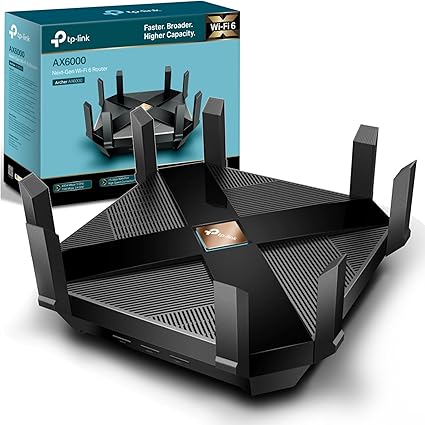Are you tired of sluggish internet speeds and struggling with multiple devices on your network? Welcome to Wi-Fi 6, the next generation of wireless technology that’s changing the way we connect online. Simply put, Wi-Fi 6 offers faster speeds, greater efficiency, and improved performance in crowded areas. Whether you’re streaming your favorite shows, gaming, or working from home, this latest upgrade provides a smoother, more reliable connection. Expect benefits like quicker load times and the ability to seamlessly manage a variety of devices at once. It’s a significant step forward for anyone looking to enhance their wireless experience right now.
We have reviews for top rated Wi-Fi 6 devices TP-Link Archer AX6000: The Ultimate Gaming Router Review [2024] TP-Link Deco X60 AX5400: Is It the Perfect Mesh Router for You? [Review]
Understanding Wi-Fi 6
Wireless communication has evolved rapidly, with each generation offering more power and efficiency. Wi-Fi 6 is no exception, representing the latest advancement in this ever-improving technology. It promises to redefine your connected experience, offering speed, reliability, and smarter connectivity. Let’s dive into what sets this new standard apart.
Evolution of Wi-Fi Standards
The journey from Wi-Fi’s inception to Wi-Fi 6 is a story of continuous improvement. Wi-Fi standards have transformed the way we communicate and access information. It all started with Wi-Fi 1, IEEE 802.11b, which set basic wireless communication at speeds up to 11 Mbps. From there, the evolution sped up with Wi-Fi 2 and Wi-Fi 3, each offering enhancements in speed and stability.
The game changed with Wi-Fi 4 (802.11n), marking a shift to higher speeds and MIMO technology, allowing multiple signals simultaneously. Wi-Fi 5 (802.11ac) further enhanced this by enabling speeds over 1 Gbps. Now, Wi-Fi 6 (802.11ax) elevates these standards, tackling congestion and efficiency issues seen in crowded spaces.
Key Features of Wi-Fi 6
Wi-Fi 6 isn’t just a simple upgrade; it’s a significant leap forward. Here are some standout features that redefine wireless connectivity:
- Higher Data Transfer Speeds: While Wi-Fi 5 offered impressive speed, Wi-Fi 6 takes it several notches up. It provides theoretical speeds up to 9.6 Gbps, but the real thrill is in how efficiently and effectively it delivers these speeds across multiple devices.
- Improved Network Efficiency: Think of Wi-Fi 6 as a masterful traffic controller. Using OFDMA (Orthogonal Frequency Division Multiple Access), it smartly allocates channels for a more efficient data exchange, crucial in environments with numerous devices.
- Enhanced Device Capacity: Do you have a smart home? Wi-Fi 6 can handle it better. It expands capacity, supporting more simultaneous device connections without losing performance.
- Better Performance in Crowded Areas: Ever tried to connect in a busy café? Wi-Fi 6 shines in such scenarios due to MU-MIMO technology, allowing multiple users to transmit simultaneously without delay.
- Reduced Latency: With its smart tech design, Wi-Fi 6 lowers latency significantly. This is a boon for gamers, streamers, and anyone who values real-time interaction.
Though the tech might sound complex, the impact is straightforward: a more seamless, faster, and reliable internet experience. It’s not just about connecting; it’s about connecting better. Imagine the possibilities with everything running smoother and quicker, from your smart fridge to your streaming marathons.
For more insights into how Wi-Fi 6 might change your home and office connectivity, visit this comprehensive guide.
Photo by Tom Fisk

Technical Specifications of Wi-Fi 6
Understanding the technical specifications of Wi-Fi 6 will help you appreciate how it enhances our digital connectivity. Wi-Fi 6 is packed with advanced features that offer remarkable improvements over its predecessors. Here’s a closer look at the technologies that make Wi-Fi 6 a powerful tool for modern network demands.
OFDMA (Orthogonal Frequency Division Multiple Access)
OFDMA is at the heart of Wi-Fi 6’s efficiency boost, enabling better handling of multiple data streams simultaneously. Imagine a busy highway where smaller lanes allow more cars to travel smoothly without jams. Similarly, OFDMA splits the Wi-Fi channel into smaller sub-channels, allocating them to different devices. This method reduces latency and improves the quality of service in environments with numerous connected devices. For those interested in the nitty-gritty details, OFDMA’s benefits are further detailed in this Qualcomm document and HUAWEI’s explanation.
1024-QAM (Quadrature Amplitude Modulation)
Wi-Fi 6 also introduces 1024-QAM, a significant leap in data transmission efficiency. Think of it as packing more information in a parcel. 1024-QAM enables Wi-Fi 6 to carry 25% more data than previous versions, enhancing throughput significantly. This improvement will be particularly noticeable in high-demand applications like video streaming and gaming, where every bit of data counts. More insights can be seen in MSI’s overview of Wi-Fi standards.
Target Wake Time (TWT)
Target Wake Time (TWT) is a clever feature aimed at enhancing battery life for connected devices. By scheduling the device’s wake and sleep times, TWT reduces unnecessary power consumption, increasing device battery life. This is a game-changer for IoT devices, which often operate on limited power. For more information on how TWT works, check out this detailed explanation by devolo.
Increased Bandwidth and Speed
One of the most exciting aspects of Wi-Fi 6 is the boost in bandwidth and speed. The potential to reach up to 9.6 Gbps is no small feat, allowing seamless streaming, swift downloads, and minimal lag during gaming sessions. It’s like upgrading from a bike to a racecar. Real-world applications reveal that these enhancements translate to more reliable connectivity and better performance, even in crowded environments. Check out Intel’s overview for more insights on these improvements.
These advanced technical specifications make Wi-Fi 6 a robust choice for future-proofing your network, ensuring faster, more reliable, and energy-efficient connectivity for all your devices.
Benefits of Wi-Fi 6
The buzz around Wi-Fi 6 isn’t just about speed; it’s about transforming the way we experience connectivity. This latest iteration of Wi-Fi technology introduces improvements that meet the demands of our increasingly connected world. Let’s break down its key benefits in terms of performance, security, and power efficiency.

Photo by Ron Lach
Improved Performance in Crowded Environments
With the rise of smart homes, work-from-home setups, and a plethora of connected devices, Wi-Fi networks are more congested than ever. Wi-Fi 6 tackles this issue head-on with MU-MIMO and OFDMA technologies, allowing multiple devices to connect without sacrificing speed or performance. Imagine a bustling highway where each car moves seamlessly without traffic jams. That’s Wi-Fi 6 in action, handling communications like a pro. It efficiently manages bandwidth distribution, ensuring every device gets its fair share of data, even when the network is packed. Read more about these enhancements from Network Computing.
Enhanced Security Features
Security is always a concern with wireless networks, and Wi-Fi 6 steps up with WPA3, the latest in Wi-Fi security protocols. WPA3 enhances encryption and provides stronger protections against attempts to break into your network. It’s like upgrading from a simple lock to a state-of-the-art security system for your digital life. This level of security is crucial as more sensitive data flows over our networks, from personal emails to financial transactions. Find detailed insights on this security update from Wi-Fi Alliance.
Better Power Efficiency
Ever noticed how quickly your devices’ batteries drain when connected to Wi-Fi? Wi-Fi 6 introduces Target Wake Time (TWT), a feature that significantly improves power efficiency. Think of TWT as a scheduled nap time for your devices, allowing them to “wake up” only when necessary and save battery when idle. This is particularly beneficial for IoT devices that rely on batteries, extending their life and reducing the need for frequent charging. Learn more about how TWT contributes to energy savings from Qualcomm’s insights.
Wi-Fi 6 is more than just a faster internet—it’s a smarter, more secure, and energy-efficient evolution that meets the needs of modern connectivity. For those eager to explore further benefits and technical details, Spiceworks offers a comprehensive overview.
Real-World Applications of Wi-Fi 6
Wi-Fi 6 is not just another iteration of wireless technology; it’s a significant leap forward that brings a multitude of real-world applications. Its broader application is not just limited to enhanced browsing speeds but extends to transforming our daily lives. Here’s how Wi-Fi 6 integrates into today’s digital fabric:
Smart Homes: The Impact of Wi-Fi 6 on Smart Home Devices
 Photo by Julio Lopez
Photo by Julio Lopez
In the realm of smart homes, Wi-Fi 6 acts as a game-changer. This newer standard supports the seamless connectivity of multiple devices, providing more bandwidth and reduced latency. Picture yourself commanding a symphony of intelligent devices—smart speakers, thermostats, lights—all working in harmony without hiccups. Faster speeds mean no more buffering as you stream your favorite shows or manage multiple devices simultaneously. As CCR Magazine highlights, this enhanced connectivity enables users to enjoy buffer-free streaming and the addition of more smart home devices without operational hassles.
IoT Devices: How Wi-Fi 6 Supports the Internet of Things
The Internet of Things (IoT) thrives on connectivity, and Wi-Fi 6 provides the robust backbone it requires. With its ability to connect more devices with better efficiency, Wi-Fi 6 is revolutionizing IoT by offering greater data rates and lower latency. This transforms how devices like sensors, cameras, and smart appliances interact. The Wi-Fi Alliance stresses that Wi-Fi 6 not only enhances performance but also supports low power operations—a crucial feature for IoT applications where energy efficiency is paramount.
Business Environments: Advantages for Businesses Adopting Wi-Fi 6
In business environments, adopting Wi-Fi 6 translates to more productive and efficient operations. Think about bustling office spaces where everyone is connected and sharing data-heavy applications. Wi-Fi 6’s expanded capacity and improved network management mean businesses can support a greater number of devices, making data flow smoothly even during peak times. It aids in reducing downtime and boosting productivity by ensuring stable and speedy internet. As noted by Intel, their testing indicates that Wi-Fi 6’s real-world advantages during office operations lead to enhanced performance and reliability.
Wi-Fi 6 is paving the way for an interconnected future, supporting diverse applications with its top-notch capabilities. From enhancing the smart home experience to empowering business operations and IoT devices, it’s revolutionizing connectivity as we know it.
Wrapping Up: The Future of Wi-Fi 6
Wi-Fi 6 is more than just a step forward in wireless technology; it’s a quantum leap in how we experience connectivity in our homes and workplaces. With its superior speed, robust security features, and unmatched efficiency, this standard is revolutionizing our digital interactions. Imagine a world where every device syncs perfectly, no matter how many are connected. It’s not just about faster internet; it’s about creating smarter, more efficient connections for everyone.
The Significance Today
Right now, Wi-Fi 6 stands as a vital technology reshaping how we connect and communicate. From enabling more efficient smart homes to improving large-scale business networks, it answers many demands of our increasingly digital lifestyles. It’s like the quiet hero that ensures everything runs smoothly behind the scenes. According to insights from Wi-Fi Alliance, Wi-Fi 6 is poised to be a key player in the IoT future, enhancing both energy efficiency and data throughput.
Future Potential
Looking ahead, the potential of Wi-Fi 6 is boundless. Its continuous evolution will further cement its role in future innovation. Imagine the possibilities it will unlock as more devices adopt this standard, especially in high-density settings like stadiums or urban areas. Furthermore, as Westermo highlights, Wi-Fi 6 is primed for applications requiring high bandwidth, such as onboard entertainment and more.
Wi-Fi 6 isn’t just an upgrade; it’s the foundation of a connected future. As technology continues to advance, Wi-Fi 6 will likely become the ubiquitous standard that enables seamless connectivity across all aspects of life. For those ready to embrace these advancements, investing in Wi-Fi 6 is a step towards smarter, faster, and more efficient digital interactions.
For more information on how Wi-Fi 6 is shaping our digital future, check out this article from iFeelTech, exploring its relevance and continuing impact.


